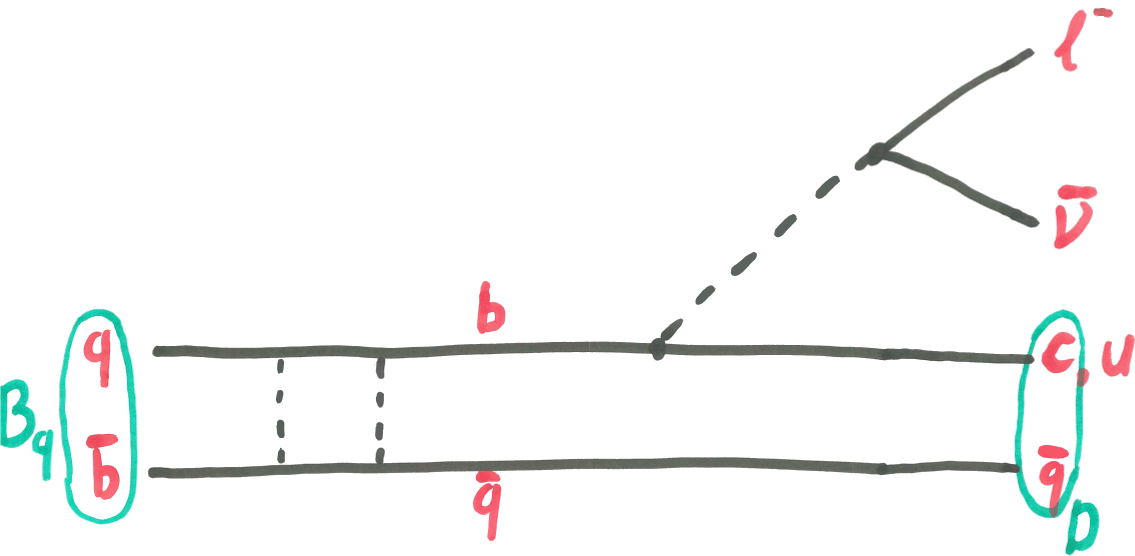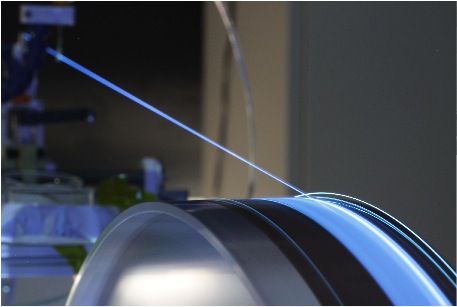Research
Why is our Universe made of matter and not of antimatter?
 This simple question implies that the laws of physics have a preference for matter.
However, the asymmetry that we observe
in our labs today is much too small to explain the matter-antimatter imbalance that we see in the Universe.
This is one of the unsolved questions in physics and it was the
main topic of my research.
I have carried out precision measurements of the smallest differences
between matter and anti-matter.
If these measurements show small deviations from their
predictions, this could be a sign of new, yet unknown particles
that influence these measurements. In this approach, we hope to find out more about the physics that governs our Universe.
This research was awarded an NWO Vidi research grant in 2013.
It was carried out between 2013 and 2018 at Nikhef using the LHCb detector at the
Large Hadron Collider at CERN.
This simple question implies that the laws of physics have a preference for matter.
However, the asymmetry that we observe
in our labs today is much too small to explain the matter-antimatter imbalance that we see in the Universe.
This is one of the unsolved questions in physics and it was the
main topic of my research.
I have carried out precision measurements of the smallest differences
between matter and anti-matter.
If these measurements show small deviations from their
predictions, this could be a sign of new, yet unknown particles
that influence these measurements. In this approach, we hope to find out more about the physics that governs our Universe.
This research was awarded an NWO Vidi research grant in 2013.
It was carried out between 2013 and 2018 at Nikhef using the LHCb detector at the
Large Hadron Collider at CERN.
Reaching the highest precision
 The smallest particles and how they interact is described by a single model, the Standard Model. This model contains quarks, leptons, force carriers and the Higgs particle. In my research I have investigated the properties of two heavy quarks, namely the c- and b-quark.
At the LHCb detector we see many millions of particles which contain a b-quark. These so-called B particles decay within one centimeter to other particles that we record in our detector. By measuring whether the B particle or anti-B particle decay at the same or different rates, we can determine this matter-antimatter asymmetry. Very often these particles decay into a particle containing a c-quark and two leptons (a charged lepton and a neutrino). This type of decay is called a semileptonic B decay, and was at the heart of my research. Since we had millions of these decays available we have measured the matter-antimatter asymmetry with the highest possible precision (at the permille level).
The smallest particles and how they interact is described by a single model, the Standard Model. This model contains quarks, leptons, force carriers and the Higgs particle. In my research I have investigated the properties of two heavy quarks, namely the c- and b-quark.
At the LHCb detector we see many millions of particles which contain a b-quark. These so-called B particles decay within one centimeter to other particles that we record in our detector. By measuring whether the B particle or anti-B particle decay at the same or different rates, we can determine this matter-antimatter asymmetry. Very often these particles decay into a particle containing a c-quark and two leptons (a charged lepton and a neutrino). This type of decay is called a semileptonic B decay, and was at the heart of my research. Since we had millions of these decays available we have measured the matter-antimatter asymmetry with the highest possible precision (at the permille level).
Research programme
 The neutral particles B0, Bs and D0
(and also K0) have the special property that they can transform into
their own antiparticle, and back. This quantum-mechanical phenomenon is called mixing.
And what we have found out is that the probability that such a particle oscillates
into its antiparticle is the same as the probability of the reverse process. This is
the topic that I have studied together with my two PhD students. Another test that I
have carried out, together with two master students, is whether B
and anti-B have the same mass. Following Einstein's relativity,
they should have the same mass and it should be independent of the velocity of the
particle (Lorentz invariant). If not then Einstein was wrong, and it would have opened up a
whole research field. Finally, with these semileptonic B decays my group has tested if the
couplings to the different lepton families are the same (lepton universality). If they
are different this could be coming from a charged Higgs particle (which is not
described in the Standard Model). To summarise, this research has measured
The neutral particles B0, Bs and D0
(and also K0) have the special property that they can transform into
their own antiparticle, and back. This quantum-mechanical phenomenon is called mixing.
And what we have found out is that the probability that such a particle oscillates
into its antiparticle is the same as the probability of the reverse process. This is
the topic that I have studied together with my two PhD students. Another test that I
have carried out, together with two master students, is whether B
and anti-B have the same mass. Following Einstein's relativity,
they should have the same mass and it should be independent of the velocity of the
particle (Lorentz invariant). If not then Einstein was wrong, and it would have opened up a
whole research field. Finally, with these semileptonic B decays my group has tested if the
couplings to the different lepton families are the same (lepton universality). If they
are different this could be coming from a charged Higgs particle (which is not
described in the Standard Model). To summarise, this research has measured
- Asymmetry in B0 mixing,
- Asymmetry in Bs mixing,
- Asymmetry in D0 decays,
- Lorentz-invariance in B0 and Bs mixing,
- Lepton universality in semileptonic B decays.
Upgrading the LHCb detector
 The LHCb detector is being upgraded between 2019 and 2021. By upgrading the LHCb detector we can improve the precision
of the measurements by a large factor. This means that we
have to redesign crucial parts of the LHCb detector, in particular the trigger and the tracking system. I have worked
on redesigning the main tracking system. This system will consist of scintillating fibres, and therefore it is called
the SciFi detector. I have worked on simulations of this upgraded detector and, with the technical department at Nikhef, on the design of the
readout box.
The LHCb detector is being upgraded between 2019 and 2021. By upgrading the LHCb detector we can improve the precision
of the measurements by a large factor. This means that we
have to redesign crucial parts of the LHCb detector, in particular the trigger and the tracking system. I have worked
on redesigning the main tracking system. This system will consist of scintillating fibres, and therefore it is called
the SciFi detector. I have worked on simulations of this upgraded detector and, with the technical department at Nikhef, on the design of the
readout box.
Publications
A selection of publications which I have written or where I have made significant contributions. A complete list can be found on Inspire and ORCiD.
Peer-reviewed articles
- LHCb collaboration, Measurement of Ds± production asymmetry in pp collisions at √s=7 and 8 TeV, JHEP 08 (2018) 008.
- LHCb OT group, Improved performance of the LHCb Outer Tracker in LHC Run 2, J. Instrum. 12 (2017) P11016.
- LHCb collaboration, Measurement of CP violation in B0→J/ψKS and B0→ψ(2S)KS decays, JHEP 11 (2017) 170.
- LHCb collaboration, Measurement of the CP asymmetry in Bs mixing, Phys. Rev. Lett. 117 (2016) 061803.
- LHCb collaboration, Search for violations of Lorentz invariance and CPT symmetry in B0(s) mixing, Phys. Rev. Lett. 116 (2016) 241601.
- LHCb collaboration, Measurement of the ratio of branching fractions B(B0→D*-τ+ν)/B(B0→D*-μ+ν) , Phys. Rev. Lett. 115 (2015) 111803.
- LHCb collaboration, A precise measurement of the B0 meson oscillation frequency, LHCb-CONF-2015-003 and EPJC 76 (2016) 1.
- LHCb collaboration, Measurement of CP violation in B0→J/ψKS, Phys. Rev. Lett. 115 (2015) 031601.
- LHCb collaboration, Measurement of indirect CP asymmetries in D0→KK and D0→ππ decays, JHEP 04 (2015) 043.
- LHCb collaboration, LHCb detector performance, Int. J. Mod. Phys. A 30, 1530022 (2015).
- LHCb collaboration, Measurement of the semileptonic CP asymmetry in B0–B0 mixing, Phys. Rev. Lett. 114 (2015) 041601.
- J. van Tilburg and M. van Veghel, Status and prospects for CPT and Lorentz invariance violation searches in neutral meson mixing, Phys. Lett B742 (2015) 236.
- LHCb collaboration, Measurement of the track reconstruction efficiency at LHCb, JINST 10 (2015) P02007
- LHCb collaboration, Measurement of CP asymmetry in D0→KK and D0→ππ decays, JHEP 07 (2014) 014.
- LHCb VELO Group, Performance of the LHCb vertex locator, JINST 9 (2014) P09007.
- LHCb collaboration, Search for direct CP violation in D0→h−h+ modes using semileptonic B decays, Phys. Lett. B 723 (2013) 33-43
- LHCb collaboration, Search for the rare decays Bs→μμ and Bd→μμ, Phys.Lett. B 699 (2011) 330-340.
- LHCb collaboration, The LHCb Detector at the LHC, JINST 3 (2008) S08005.
Thesis
- J. van Tilburg, Track simulation and reconstruction in LHCb, PhD thesis, CERN-THESIS-2005-040.
Proceedings
- J. van Tilburg, Measurements of CPT violation at LHCb, CPT'16, arXiv:1607.03620.
- J. van Tilburg, Recent hot results from LHCb, Moriond, 2016 Electroweak Interactions and Unified Theories.
- J. van Tilburg, Charm physics, LHCP2013, EPJ Web of Conferences 60, 04004 (2013).
- J. van Tilburg, Search for New Physics in Heavy Quark Decays at LHCb, BEACH2010, Nucl.Phys.Proc.Suppl. 210-211 (2011) 57-60.
- J. van Tilburg et. al., Commissioning and performance of the LHCb Silicon Tracker, 12th Vienna Conference on Instrumentation, Nucl. Instrum. Meth. A 628 (2011) 69–72.
- J. van Tilburg, Γ determination from tree decays (B→DK decays) with LHCb, Lake Louise Winter 2008, Fundamental Interactions, 447-451.
- J. van Tilburg, Tracking Performance in LHCb, LHC2003 Symposium, Eur. Phys. J. C 34, s01 s397-s401 (2004).
LHCb reports
- LHCb collaboration, LHCb Tracker Upgrade TDR, LHCb-TDR-015.
- LHCb collaboration, Roadmap for selected key measurements of LHCb, arXiv:0912.4179.
- LHCb collaboration, LHCb reoptimized detector design and performance TDR, LHCb-TDR-9.
- LHCb collaboration, LHCb outer tracker TDR, LHCb-TDR-6.
LHCb public notes
- J. van Tilburg et. al., The digitisation of the scintillating fibre detector, LHCb-PUB-2014-003
- J. van Tilburg et al., Measurement of the track finding efficiency, LHCb-PUB-2011-025.
- J. van Tilburg, Studies of the Silicon Tracker resolution using data, LHCb-PUB-2010-016.
- J. van Tilburg, F. Blanc and H. Voss, Additional measurements of the magnetic field in LHCb, EDMS note 1076427.
- J. van Tilburg, Safety instructions and procedures for the Tracker Turicensis, EDMS 945529.
- J. van Tilburg and C. Salzmann, TT detector description and implementation of the survey measurements, LHCb-2008-061.
- J. van Tilburg, Operational procedure for the opening and closing of the TT detector, EDMS 929560.
- D. Volyanskyy and J. van Tilburg, Selection of the Bs→J/ψ(μ+μ-)η’(ρ0γ) decay at LHCb and its sensitivity to the Bs mixing phase φs, LHCb-2007-027.
- E. Bos, M. Merk, G. Raven, E. Rodrigues and J. van Tilburg, The Trajectory Model for Track Fitting and Alignment, LHCb-2007-008.
- M. Needham and J. van Tilburg, Performance of the track matching, LHCb-2007-020.
- J. van Tilburg and O. Steinkamp, PPSPS: Installation of the Trigger Tracker, EDMS 807742.
- W. Baldini et. al., LHCb Alignment Strategy, LHCb-2006-035.
- J. Nardulli and J. van Tilburg, Outer Tracker Event Data Model, LHCb-2005-004.
- J. van Tilburg, Outer Tracker Software, LHCb-2003-062.
- M. Merk et. al., Optimizing the Outer Tracker near the y=0 region, LHCb-2003-019.
- J. van Tilburg, Matching VELO tracks with tracks from the Main Tracker, LHCb-2001-117.
- J. van Tilburg, Matching VELO tracks with seeding tracks, LHCb-2001-103.
- M. Merk et. al., An improved digitization procedure for the Outer Tracker, LHCb-2001-055.

